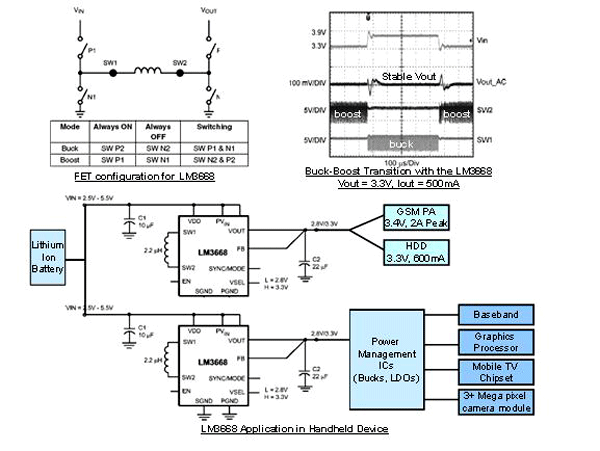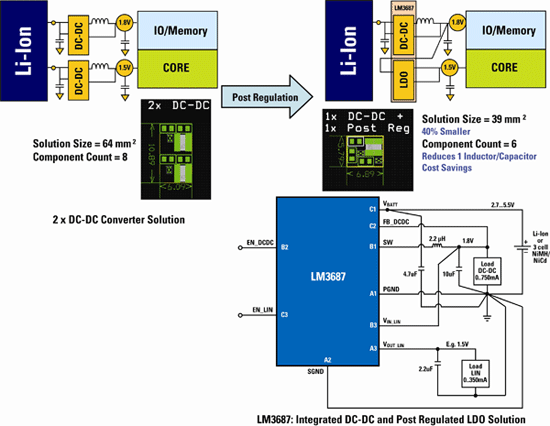Enabling multimedia in next generation handhelds
Solving handheld energy management challenges
BY VIK SANGHA
National Semiconductor
Santa Clara, CA
http://www.national.com
The personal handheld is evolving rapidly to keep pace with the increasing demands of the consumer for entertainment and information on-the-go. The two burgeoning trends for handhelds are multimedia and ubiquitous connectivity. The desire for mobile entertainment has led to strong growth in mobile TV and gaming applications. In addition, consumer dependence on the internet has created a rush to develop handhelds that can support fast internet access through standards like Wi-Fi, WiMAX and WCDMA (Wideband Code Division Multiple Access).
However, personal handhelds are powered by finite sources of energy. The addition of new features is increasing the average rate of energy consumption of these batteries. Functions like mobile TV and faster data rates have also increased the operational time per user. Lithium ion battery technology is not evolving fast enough to support the increasing energy needs. There is an express need to add more innovative energy management techniques to maintain suitable handheld runtimes. New power management techniques like buck-boost regulation and post regulation offer practical, compact and easy to use solutions to enable the new echelon of portable multimedia engines .
Extending li-ion battery range
There is a need for portable hard-disk drives (HDDs) in multimedia devices to download MP3s and videos. These HDDs have a voltage requirement of 3.3 V to drive the mechanical head arm and actuator. The functional range of a lithium-ion battery is from 3.0 to 4.2 V (nominal range is 2.7 to 5.5 V but there is negligible energy outside the functional range) There is a need for a buck-boost dc/dc converter to support the 3.3 V rail from the lithium-ion battery while providing the highest efficiency possible. When the input voltage (Vin) is greater than 3.3 V, the buck-boost dc/dc converter steps the voltage down. As the battery starts to decay and the Vin range falls below 3.3 V, the buck-boost seamlessly transitions from step-down to boost operation to maintain a precise and stable 3.3 V rail.
Another high voltage application is a GSM cell phone power amplifier (PA) which requires output voltages as high as 3.4 V. Since most GSM PAs are powered directly from the lithium-ion battery, they dictate the battery voltage where the handheld shuts down. A system without a buck-boost regulator has to shutdown at a higher voltage (~3.5 V) resulting in shorter run times. The run time loss between shutting down at 3.5 V versus at 3.0 V is 10 to 20%. This run time can be salvaged by putting a buck-boost between the battery and the load. Figure 1 shows the architecture of the LM3668 synchronous buck-boost dc/dc converter from National Semiconductor and its smooth transition between step-up and step-down operation as the Vin changes.

Fig. 1. Buck-boost architecture and system implementation
Another major challenge in portable handhelds is the increasing peak current requirements of the system. Most handhelds have added additional graphics processors to support functions like 3D graphics and digital image processing. These processors have peak currents as high as 1.5A. In addition, new features like mobile TV are further increasing the current requirement of a system. The amplified demands of the digital sub-systems together with the RF system requirements can result in very large in-rush currents from the battery resulting in large droops in battery voltage. For example, in a GSM phone, a simultaneous 1.5 A (3.4 V) GSM pulse and 1.5 A (1.8 V) pulse from the processor will result in a battery current of about 2.3 A. The nominal dc resistance of a lithium ion battery is rated at 150 mΩ, rising to approximately 200mΩ at -30°C (lower end of commercial temperature range.) The resulting sag in the battery voltage at -30°C is 460 mV. This creates the problem of having to set the shutdown battery voltage of the system much higher therefore giving up significant run times. The solution is to use a buck-boost dc/dc converter as a pre-regulator to the power management ICs (integrated circuits) powering the digital sub-system as shown in Figure 1 . For example, the LM3668 is able to provide a stable 3.3-V input to the power management circuitry regardless of the fluctuation of the battery voltage thus salvaging extra run time from the battery and preventing any inadvertent failures due to Vin fluctuations. It is essential that pre-regulators are very efficient to maximize the benefits and the LM3668 achieves this by providing PFM operation at light loads and also by minimizing switching losses in PWM mode.
Enabling smallest form factor and optimized BOM
The addition of new features to handhelds has increased the component count on the phone board but the circuit board continues to shrink as suppliers want to make the sleekest of handhelds. The resulting challenge is a tremendous space crunch mandating smaller solutions for all segments. In power management, this challenge is further accentuated by the need to improve run-times. A popular upgrade to a power management system has been to replace linear regulator solution with a compact synchronous switching regulator solution. However, the smallest step-down dc/dc converter is 3 times the size and more expensive with the addition of an inductor and larger input and output capacitors.
An effective alternative to a step-down dc/dc converter is post regulation. The premise is to use a dc/dc converter to generate a power rail that can also be use as an input to a low input voltage linear regulator. The end result is a solution that is almost as efficient as two inductive switchers but much more compact and economical. Figure 2 shows a comparison between the two solutions. Post regulation saves 40% board space and reduces solution cost by eliminating external components. However, there is almost no efficiency hit with the post regulated solution. Efficiency is optimized by minimizing the dropout voltage between the input and output of the low input linear regulator.

Fig. 2. Post regulation application using the LM3687
From Figure 2 , the efficiency of the 1.5 V LDO(low drop-out) regulator is 83.3% . This is comparable to dc/dc converter efficiency and much higher than that of a normal LDO solution powered directly from the battery. For a processor consuming 500 mA for the core and 300 mA for the I/O and memory (assuming Vin = 3.6 V and dc/dc converter efficiency of 85%), the difference in battery current for a dual dc/dc converter versus a post-regulated solution is only 5 mA. Since battery current rather than percentage efficiency is the real gauge of battery life, it is fair to say that the post regulated solution has negligible detrimental effect on run-time. The difference between the core and I/O (input/output) voltage requirements of next generation graphics processor is getting smaller day by day. A common I/O voltage is 1.8 V, and the core voltage varies between 1.2 and 1.6 V. These voltage combinations are ideal for post regulation with the dc/dc supplying the I/O voltage and the LDO supplying the core voltage. The LM3687 from National Semiconductor is a dual channel solution that integrates the step-down dc/dc converter and the low Vin linear regulator into a single chip.
Power management is a key enabler of the multimedia revolution in handhelds. Power solutions are no longer only about efficient power regulation but progressively more about solving handheld energy management challenges. Power designers need to keep system level challenges in mind in order to define outstanding power ICs for the portable handheld maker.
Advertisement
Learn more about National Semiconductor





